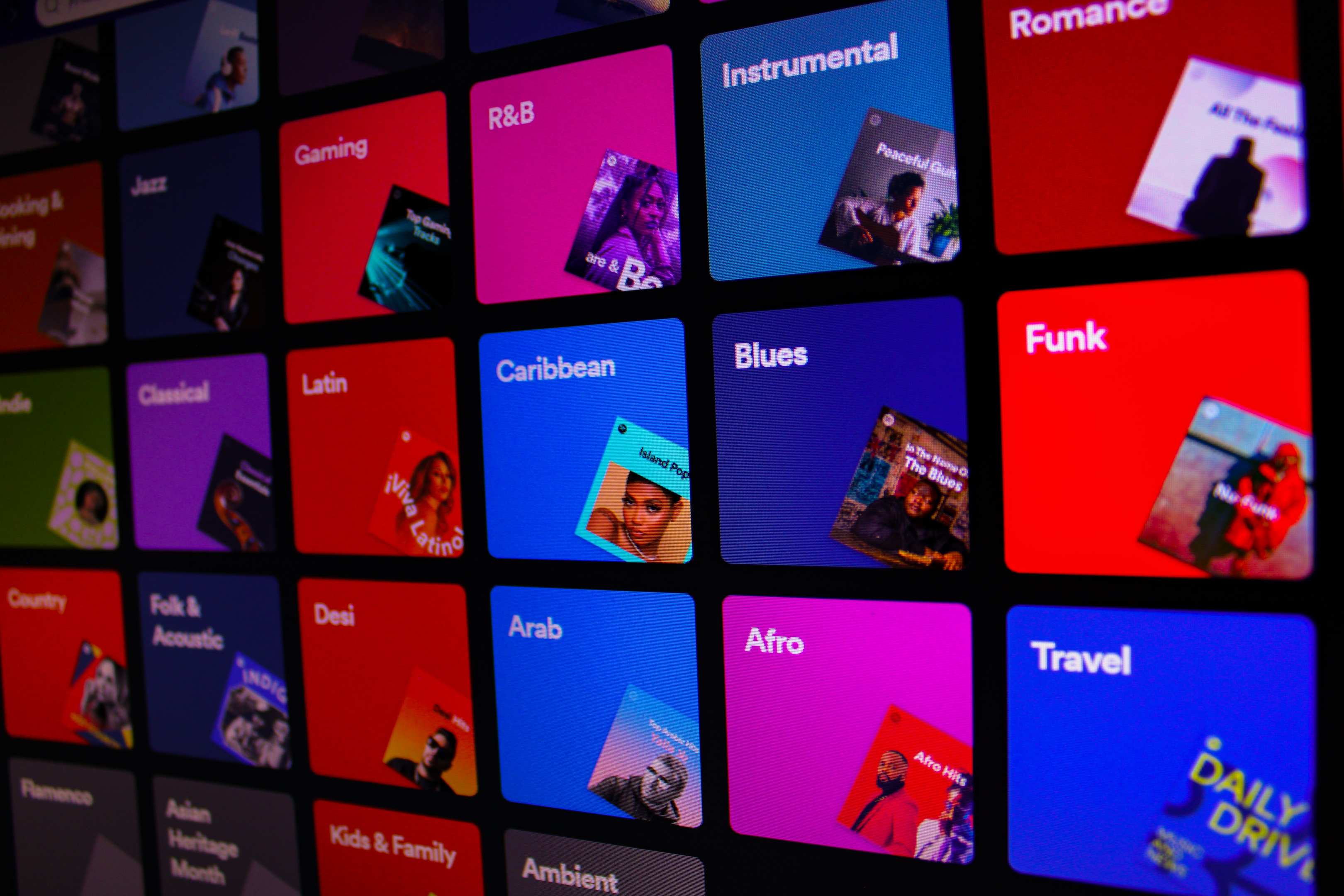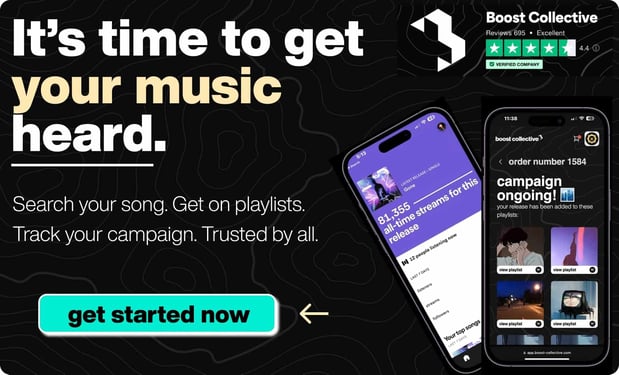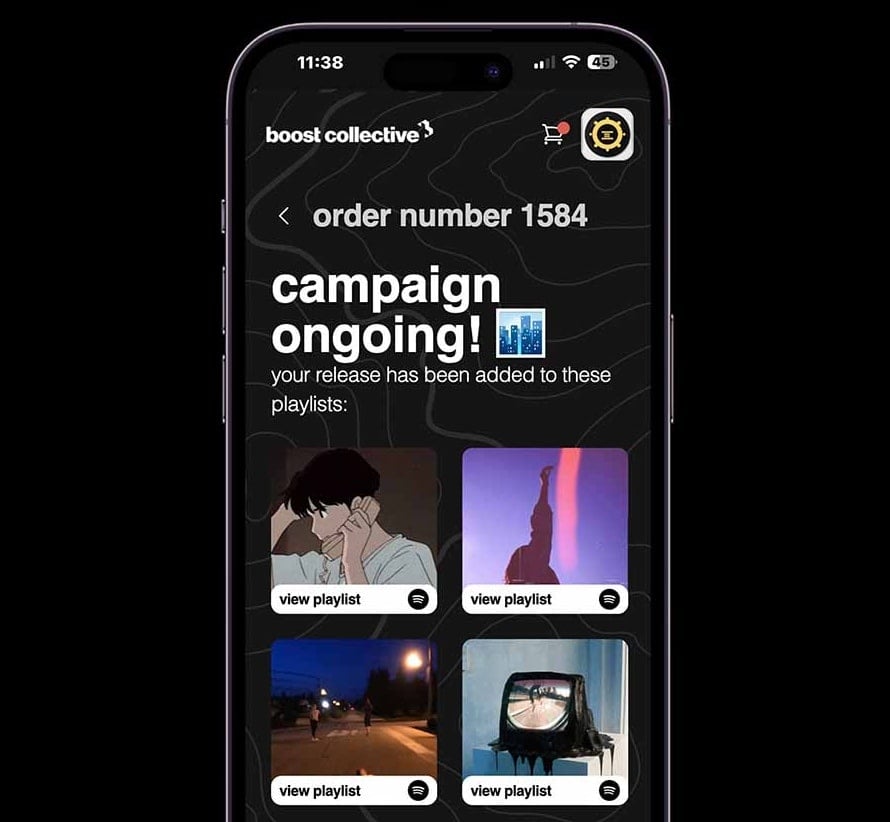Overview

Have you ever wondered how music streaming services like Spotify and Apple Music suggest new songs, tracks, and albums, that perfectly match your taste?
It's all thanks to their complex algorithms that analyze and track your listening habits and recommend new album tracks hit songs, accordingly.
Introduction
Music streaming has revolutionized the way we consume music. Instead of buying individual albums or songs, we can now access millions of tracks instantly with just a click.
But the success of the vast majority of these services isn't just due to their vast collection of music; or more listeners, it's their ability to personalize the listening and playing experience for each user.
The role of music streaming algorithms in the industry cannot be overstated. These algorithms not only improve user experience but also impact the success of artists and the industry at large.
In this feature, we'll take a closer look at how these song name algorithms work and their impact on the music industry.
Definition Of Music Streaming Platforms
Music streaming platforms are online services that allow users to access and listen to a vast catalog of music through the internet.
These platforms provide a convenient and legal way to stream music on various devices, such as smartphones, tablets, computers, and smart speakers.
The key features and characteristics of music streaming platforms include:
-
Catalog: Music streaming platforms offer an extensive collection of songs from various genres, artists, and albums. They typically have licensing agreements with record labels and music publishers to provide a wide range of music options to their users.
-
On-Demand Streaming: Users can choose and play any song or album from the platform's catalog whenever they want, on-demand. This allows for personalized listening experiences and gives users control over the music they want to hear.
-
Playlists And Recommendations: Music streaming platforms often provide curated playlists and personalized recommendations based on the user's listening history, preferences, and algorithms. This helps users discover new music and create customized playlists for different moods, occasions, or genres.
-
Offline Listening: Many music streaming platforms offer the option to download songs or playlists for offline listening. This allows users to listen to music even when they don't have an internet connection, such as during travel or in areas with limited connectivity.
-
Social Sharing And Integration: Users can share their favorite songs, playlists, or music discoveries with others through social media platforms or within the streaming platform's community. Some platforms also integrate with social media accounts, allowing users to see what their friends are listening to and share music recommendations.
-
Multiple Devices And Platforms: Music streaming platforms are accessible on various devices, including smartphones, tablets, computers, smart TVs, and smart speakers. They often provide apps or web players compatible with different operating systems and platforms to ensure seamless accessibility.
-
Subscription Model: Most music streaming platforms operate on a subscription-based model, where users pay a monthly fee to access the platform's features without advertisements. Some platforms also offer free, ad-supported versions with limited features.
Overall, music streaming platforms have revolutionized the way most people consume and discover music, providing easy access to a vast library of songs and enhancing the overall music listening experience.
Importance Of Music Streaming In The Industry

Music streaming has revolutionized the music industry in numerous ways, making it an essential component of the modern music landscape. Here are some key reasons highlighting the importance of music streaming in the industry:
-
Accessible And Convenient: Music streaming platforms have made music more accessible than ever before. Listeners can stream their favorite songs instantly with just an internet connection, eliminating the need for physical music formats or downloads. This convenience has significantly expanded the audience's reach and engagement with music.
-
Global Reach: Music streaming platforms have a global presence, allowing artists to reach a vast audience worldwide. Unlike traditional distribution methods, which often require physical distribution or licensing deals, streaming platforms enable artists to connect with fans across borders, breaking down geographical barriers.
-
Discoverability And Exposure: Streaming services offer advanced algorithms and personalized recommendations, allowing users to discover new music based on their preferences. This has created a more level playing field for both established and emerging artists, allowing them to gain exposure and connect with new listeners.
-
Revenue Generation: While the music industry faced significant challenges with declining physical sales and piracy in the past, streaming has emerged as a viable revenue stream. Streaming platforms pay royalties to artists and rights holders based on the number of streams their songs receive. While the revenue distribution model has been a topic of discussion, streaming has provided artists with a consistent income source, especially for independent and niche artists.
-
Data And Analytics: Streaming platforms generate a wealth of data and analytics, providing valuable insights to artists, labels, and industry professionals. This data helps them understand listener behavior, demographics, and preferences, enabling them to make informed decisions regarding marketing, touring, and content creation. Artists can also gauge the popularity of their music and track their performance metrics.
-
Promotional And Collaborative Opportunities: Streaming platforms often feature curated playlists, artist spotlights, and collaborations with brands, enhancing promotional opportunities for artists. Being featured on a popular playlist or partnering with a brand can significantly boost an artist's visibility, helping them reach a wider audience and potentially leading to other opportunities such as live performances or licensing deals.
-
Adaptability And Innovation: Music streaming has continuously evolved to meet the changing demands of listeners and artists. Platforms have introduced features like offline listening, high-quality audio, live streaming, and interactive experiences, providing a more immersive and personalized music consumption experience.
Overall, music streaming has transformed the industry by democratizing access to music, providing revenue streams, enabling discovery, and facilitating global reach.
Its importance cannot be overstated as it has become the dominant mode of music consumption, shaping the way many artists create, distribute, and monetize their music in the digital age.
Evolution Of Music Streaming Algorithms
Early Stages Of Music Streaming And Manual Curation
In the early stages of music streaming, manual curation played a significant role in shaping the content available to users. Before algorithms and personalized recommendations became prominent, human curators were responsible for creating personal playlists, organizing music libraries, and selecting featured new songs or artists.
During this period, music streaming platforms often employed teams of curators who had expertise in various genres or musical styles. These curators would manually review all streams and select songs to be included in playlists based on factors such as the popularity of the song, the artist's featured song name, genre, mood, and thematic relevance. They would create curated playlists with specific themes like "Chill Vibes," "Workout Jams," or "Indie Discoveries."
Manual playlist curation offered several advantages. It allowed for a more personalized and human touch to the music discovery and playing experience, ensuring that all the stuff and people engaged in playlists were carefully crafted and catered to specific tastes or moods. It also provided opportunities for lesser-known artists to be discovered and showcased alongside established ones.
However, manual curation also had its limitations. The sheer volume of music available made it challenging for curators to keep up with the constantly expanding libraries. It was difficult to cover every niche or subgenre comprehensively, and there was always a subjective element involved in the selection process between similar songs, which might not align with individual preferences.
As technology advanced and machine learning algorithms became more sophisticated, music streaming platforms started integrating automated recommendation systems.
These systems utilized user data, listening patterns, and collaborative filtering techniques to generate personalized playlists and recommendations. Gradually, the role of manual curation shifted to working alongside algorithms, with curators refining and improving the algorithmic playlists and recommendations provided by the automated recommendation systems themselves.
Today, music streaming services combine the power of both manual curation and algorithmic recommendations. Human curators continue to make personal, playlist additions and playlist additions and have a crucial role in creating high-quality playlists and editorial content, while algorithms handle the vast scale of content and individualized recommendations.
The evolution of music streaming has allowed for a more diverse and accessible music landscape, enabling users to explore the genre and discover music from all around the world. The combination of manual curation and algorithmic recommendations has significantly enhanced the user's library experience and made music streaming a popular and convenient way to consume music.
How Music Streaming Algorithms Work
Music streaming algorithms work by using a combination of user data, metadata, and machine learning techniques to deliver personalized music recommendations to users.
Here's a general overview of how they work:
-
Collection Of User Data: Streaming platforms collect various data points about users and their music preferences. This can include listening history, song ratings, playlists, skipped tracks, likes, and other interactions with the platform. Some platforms may also gather additional data from external sources, such as social media profiles or demographic information.
-
Building User Profiles: The collected data is used to build user profiles that capture their music preferences, habits, and interests. These profiles are dynamic and constantly updated as users interact with the platform.
-
Metadata Analysis: Metadata refers to information associated with each song, such as genre, artist, release date, and tempo. Algorithms analyze this metadata to identify patterns and similarities between songs.
-
Collaborative Filtering: Collaborative filtering is a common technique used in music streaming algorithms. It looks for users with similar music preferences and recommends songs or artists that those similar users have enjoyed. For example, if two users have a high overlap in their listening history, the algorithm may recommend songs that one user has listened to but the other hasn't.
-
Content-Based Filtering: Content-based filtering focuses on the characteristics of the music itself, rather than relying solely on user behavior. It analyzes the audio features of songs, such as tempo, key, instrumentation, and style, to identify similarities and recommend songs that have similar attributes to those a user has enjoyed in the past.
-
Machine Learning Models: Machine learning algorithms are used to process the collected data, generate predictions, and improve recommendations over time. These models can use various techniques, such as decision trees, clustering, or deep learning, to identify patterns and make accurate predictions about user preferences.
-
Feedback Loop: User feedback plays a crucial role in refining the recommendations. Platforms often incorporate feedback mechanisms such as thumbs-up or down buttons, allowing users to indicate their preferences. This feedback is then used to update the user profiles and improve future recommendations.
-
Serendipity And Discovery: To introduce variety and help users discover new music, streaming platforms often incorporate an element of serendipity. They may include recommendations from popular charts, new releases, curated playlists, or personalized recommendations from popular artists or influencers.
-
Real-Time Adaptation: Streaming algorithms continuously learn and adapt based on user behavior and feedback. As users interact with the platform and their preferences evolve, the algorithms adjust the recommendations accordingly.
It's important to note that each music streaming platform may have its own proprietary algorithms and techniques, and the specifics may vary.
However, the general principles of utilizing user data, metadata analysis, collaborative and content-based filtering, and machine learning are common elements in the functioning of music streaming algorithms.
Benefits Of Music Streaming Algorithms
Music streaming algorithms have brought significant benefits to both users and the music industry.
Here are some of the key advantages:
-
Personalized Recommendations: Music streaming algorithms use machine learning and user data analysis to provide personalized music recommendations. These algorithms consider your listening history, preferences, and behavior to suggest songs, albums, and playlists tailored to your taste. This enhances music discovery, introduces you to new artists, and keeps your listening experience fresh and engaging.
-
Enhanced Music Discovery: Traditional methods of music discovery, such as radio or physical record stores, were limited in scope. Streaming algorithms expose users to a wide range of genres, artists, and songs they may not have encountered otherwise. This expands musical horizons and helps independent or lesser-known artists gain exposure, fostering a more diverse music ecosystem.
-
Improved User Engagement: By offering personalized recommendations and a vast library of songs, music streaming algorithms keep users engaged with the platform. They create a sense of discovery and novelty, encouraging users to spend more time exploring new music. Increased user engagement leads to longer sessions, higher retention rates, and ultimately, a stronger connection between users and the platform.
-
Convenience And Accessibility: Music streaming algorithms have revolutionized the way we access and consume music. Users can instantly access millions of songs from various devices, eliminating the need for physical music collections or manual downloads. This convenience allows for on-the-go listening and easy sharing of music with others, making it accessible to a global audience.
-
Data-Driven Insights: Streaming algorithms collect and analyze vast amounts of user data, providing valuable insights to the music industry. Artists, record labels, and music platforms can leverage this data to understand trends, user preferences, and emerging markets. This information helps in making informed decisions regarding artist promotion, playlist curation, marketing strategies, and investment in new talent.
-
Monetization And Royalties: For the music industry, streaming algorithms play a crucial role in monetizing digital music consumption. Streaming services pay royalties to artists based on the number of streams their songs receive. Algorithms help in optimizing the distribution of royalties by accurately tracking and attributing streams. This transparency benefits artists, ensuring fair compensation for their work.
-
Music Curation: Streaming algorithms are used to curate playlists and radio stations based on specific moods, activities, or themes. This curated content provides a seamless and enjoyable listening experience for users. It also helps in discovering music suitable for different occasions, enhancing the overall entertainment value.
It's important to note that while music streaming algorithms offer numerous benefits, there are also concerns regarding their impact on artist revenue, fair compensation, and potential homogenization of music taste.
Striking the right balance between algorithmic recommendations and supporting diverse artists remains an ongoing challenge for the music industry.
Criticisms And Concerns About Music Streaming Algorithms

While music streaming algorithms have revolutionized the way we discover and consume music, there are valid criticisms and concerns associated with their usage.
Here are some of the main criticisms and concerns raised about music streaming algorithms:
-
Limited Diversity: One common criticism is that streaming algorithms often prioritize popular and mainstream music, resulting in a lack of diversity in the music that gets recommended to users. This can make it difficult for lesser-known or niche artists to gain exposure and reach a wider audience.
-
Homogenization Of Tastes: Streaming algorithms have been accused of promoting a homogenization of musical tastes by continuously suggesting similar or related songs based on a user's listening history. This can create an echo chamber effect, where users are less likely to be exposed to new genres or artists that fall outside their usual preferences.
-
Bias And Exclusion: There have been concerns about inherent biases in streaming algorithms, including racial, cultural, and gender biases. Algorithms might inadvertently exclude or underrepresent certain genres, artists, or demographics, leading to an unequal distribution of opportunities and exposure.
-
Manipulation And Gaming The System: Some artists and labels have been accused of manipulating streaming algorithms to boost their visibility and increase their streams artificially. This can involve tactics such as playlist placement, incentivizing repeated plays, or using fake accounts to inflate streaming numbers.
-
Royalty Distribution: The royalty system in music streaming is often criticized for being skewed in favor of major record labels and popular artists, while leaving lesser-known or independent artists with meager earnings. Streaming algorithms can contribute to this issue by reinforcing the dominance of established artists and limiting the visibility of emerging or niche acts.
-
Lack Of Contextual Understanding: Algorithms primarily rely on user data and behavior patterns to make recommendations. However, this approach lacks a deep contextual understanding of the music itself, such as lyrics, emotions, or cultural significance. As a result, the recommendations might not accurately capture the nuanced preferences of listeners or provide meaningful connections between songs.
-
Privacy Concerns: Streaming algorithms heavily rely on collecting and analyzing user data to make personalized recommendations. This raises privacy concerns regarding the extent of data collection, the security of personal information, and the potential for data misuse or breaches.
-
Impact On Album Listening And Artistic Intent: Streaming algorithms typically favor individual songs over full albums. This can diminish the concept of the album as a cohesive artistic work, as artists may feel pressured to prioritize creating hit singles rather than exploring more complex and thematic compositions.
Addressing these criticisms and concerns requires a combination of efforts from streaming platforms, artists, listeners, and industry stakeholders.
Striking a balance between personalized recommendations and fostering diversity, transparency in recommendation algorithms, and fair royalty distribution can help alleviate some of the issues associated with music streaming algorithms.
Challenges And Future Directions Of Music Streaming Algorithms
Music streaming algorithms have revolutionized the way we discover, access, and enjoy music.
However, there are still several challenges and future directions that can further enhance the user experience and address various concerns.
Here are some key challenges and potential future directions for music streaming algorithms:
-
Personalization And Diversity: While music streaming algorithms have made significant strides in personalized recommendations, there is still room for improvement. Current algorithms often rely heavily on user preferences and behavior, which can lead to echo chambers and limited exposure to new genres and artists. Future directions should focus on balancing personalization with the promotion of diversity, helping users discover a wider range of music.
-
Contextual Understanding: Music recommendations should consider the contextual factors that influence a user's preferences, such as the time of day, location, mood, or activity. Integrating context-aware algorithms can enhance the listening experience by offering appropriate recommendations based on the user's current situation.
-
Long-Term User Modeling: Most music streaming platforms primarily focus on short-term user preferences. Future algorithms could benefit from long-term user modeling, taking into account evolving tastes and interests. By understanding a user's musical journey over time, platforms can provide more accurate and relevant recommendations.
-
Fairness And Transparency: There is a growing concern regarding algorithmic biases and the lack of transparency in how recommendations are generated. Future directions should prioritize fairness in recommendations, avoiding discriminatory or exclusionary practices. Additionally, providing explanations for recommendations can increase transparency and help build user trust.
-
Discoverability And Emerging Artists: Established artists often dominate the recommendation algorithms, making it challenging for emerging or niche artists to gain exposure. Enhancing the discoverability of lesser-known artists through curated playlists, genre-specific recommendations, or collaborations with independent music curators can address this challenge.
-
User Control And Serendipity: While personalized recommendations are valuable, users also appreciate serendipitous discoveries. Future algorithms should strike a balance between personalization and unexpected recommendations, allowing users to have more control over their listening experience and encouraging exploration.
-
Multi-Modal Recommendations: Music is often enjoyed alongside other media, such as videos, podcasts, or live performances. Incorporating multi-modal recommendations that consider the user's preferences across different media formats can create a more immersive and engaging experience.
-
Collaborative Filtering: Expanding collaborative filtering techniques beyond user-item interactions to include social and cultural factors can provide more accurate recommendations. Considering the influence of friends, social networks, or broader communities can help capture the collective tastes and interests of users.
-
Real-time Adaptability: Music preferences can change quickly, and algorithms should adapt accordingly. Integrating real-time feedback mechanisms and user input can help the algorithms respond promptly to evolving user preferences, ensuring more up-to-date recommendations.
-
Ethical Considerations: Future directions should address ethical considerations surrounding the use of user data, privacy, and the impact of algorithms on the music industry. Striking a balance between commercial interests, user preferences, and artists' rights is essential for a sustainable and equitable music streaming ecosystem.
In conclusion, while music streaming algorithms have come a long way, there are still several challenges to overcome and future directions to explore.
By prioritizing personalization of fan engagement, contextual artist understanding, fairness, and user control, music streaming platforms can enhance the listening experience, promote artist diversity, and support emerging artists.
The Wrap-Up (Streaming Services Algorithm)

In conclusion, the role of music streaming algorithms in the industry had a profound impact on artists' music fans' songs, musicians, and listeners alike.
These algorithms have revolutionized the way music is discovered, consumed, and shared, allowing for personalized and tailored experiences for more listeners.
By analyzing user preferences, listening habits, and vast amounts more streams and other tracks of data, streaming platforms can provide users with a continuous stream of music that aligns with their tastes, leading to more streams and increased engagement and satisfaction.
Furthermore, these algorithms have also played a significant role in promoting emerging female artists too, enabling them to reach wider audiences and gain exposure in a highly competitive industry.
However, it is crucial to strike a balance between algorithmic recommendations for most artists and the need for diversity, ensuring that artists from various genres and backgrounds receive equitable opportunities.
As the industry continues to evolve, the role of music streaming algorithms will undoubtedly remain vital, shaping the way we discover and enjoy music for years to come.
Get your music on playlists now.
It’s time you get your exposure and listeners up - playlisting by Boost Collective has been trusted by 50,000+ artists worldwide.
It’s easy: Search your song, get on playlists, and track your campaign.
What’re you waiting for? Tap in - and get added to playlists in 24 hours.
Join Boost Collective for free here.

